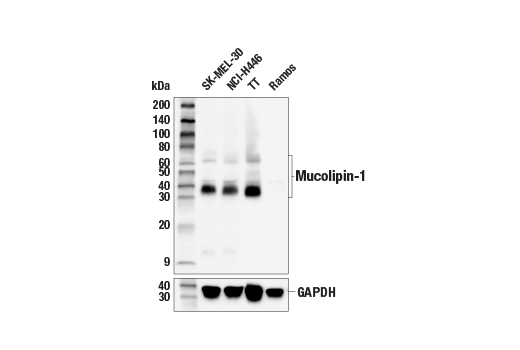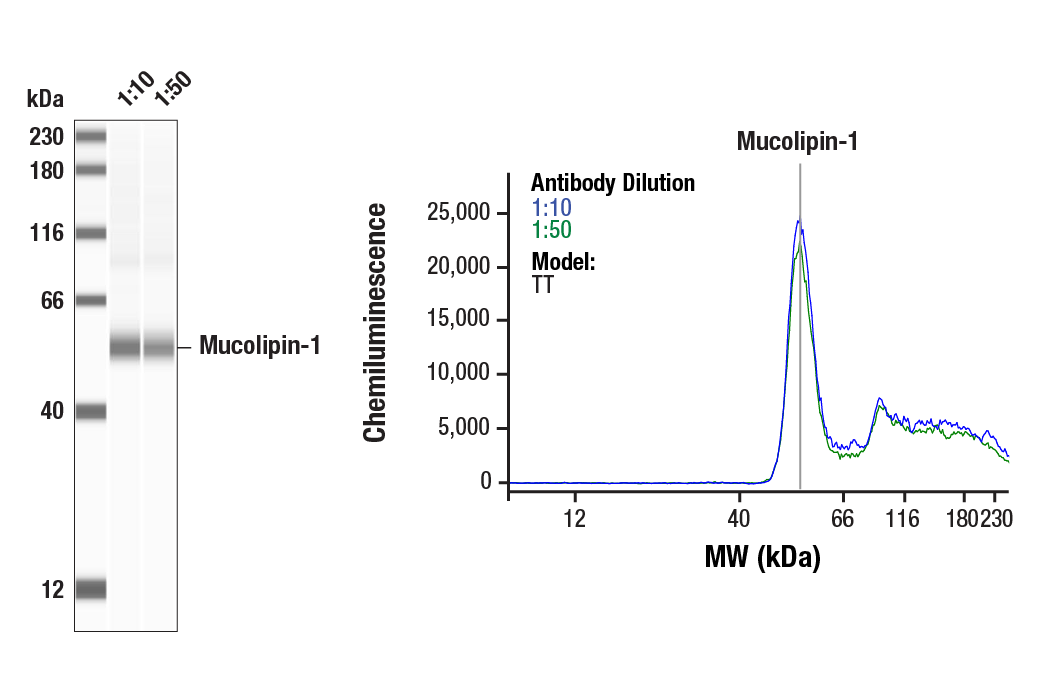WB, W-S
H
Endogenous
35-40, 65
Rabbit
#Q9GZU1
57192
Product Information
Product Usage Information
| Application | Dilution |
|---|---|
| Western Blotting | 1:1000 |
| Simple Western™ | 1:10 - 1:50 |
Storage
Specificity / Sensitivity
Species Reactivity:
Human
Source / Purification
Polyclonal antibodies are produced by immunizing animals with a synthetic peptide corresponding to residues near the carboxy terminus of human mucolipin-1 protein. Antibodies are purified by peptide affinity chromatography.
Background
Mucolipin-1 (MCOLN1, TRPML1), a member of the transient receptor potential ion channel superfamily, is a lysosomal/late endosome Ca2+ efflux channel that is important in lysosomal biogenesis (1,2). Mutations in the mucolipin-1 gene are responsible for the human lysosomal storage disease mucolipidosis type IV (MLIV), an autosomal recessive neurodegenerative disease (3). Mucolipin-1 is synthesized as a 580-amino acid protein with six transmembrane domains but can undergo cleavage in the long luminal loop between the first two transmembrane domains (4,5). Mucolipin-1 activity has been linked to autophagy and lysosomal biogenesis. Calcium influx through mucolipin-1 activates CaMKKβ and AMPK, which activate the autophagy kinase ULK1 (6). Calcium influx is also associated with activation of the calcium-dependent phosphatase calcineurin which can trigger activation of TFEB, a key transcription factor regulating autophagy and lysosomal biogenesis (7,8). Mucolipin-1 activity is upregulated by cellular stress, including reactive oxygen species (ROS) (7). Phosphorylation of mucolipin-1 by mTOR results in reduced channel activity and autophagic flux (9). Loss of mucolipin-1 or pharmacological inhibition suppresses autophagy and can reduce tumor growth and metastasis in non-small cell lung cancer and triple-negative breast cancer, suggesting the use of mucolipin-1 antagonists for cancer therapy (10-12).
- Zeevi, D.A. et al. (2007) Biochim Biophys Acta 1772, 851-8.
- Cheng, X. et al. (2010) FEBS Lett 584, 2013-21.
- Mirabelli-Badenier, M. et al. (2015) Metab Brain Dis 30, 681-6.
- Kiselyov, K. et al. (2005) J Biol Chem 280, 43218-23.
- Miedel, M.T. et al. (2006) J Biol Chem 281, 12751-9.
- Scotto Rosato, A. et al. (2019) Nat Commun 10, 5630.
- Zhang, X. et al. (2016) Nat Commun 7, 12109.
- Zhang, X. et al. (2016) Autophagy 12, 1954-1955.
- Onyenwoke, R.U. et al. (2015) Biochem J 470, 331-42.
- Yin, C. et al. (2019) Cancer Manag Res 11, 8607-8617.
- Xu, M. et al. (2019) Cell Calcium 79, 80-88.
- Yang, Y. et al. (2020) Cells 9, 2682-2688.
Species Reactivity
Species reactivity is determined by testing in at least one approved application (e.g., western blot).
Western Blot Buffer
IMPORTANT: For western blots, incubate membrane with diluted primary antibody in 5% w/v nonfat dry milk, 1X TBS, 0.1% Tween® 20 at 4°C with gentle shaking, overnight.
Applications Key
WB: Western Blotting W-S: Simple Western™
Cross-Reactivity Key
H: human M: mouse R: rat Hm: hamster Mk: monkey Vir: virus Mi: mink C: chicken Dm: D. melanogaster X: Xenopus Z: zebrafish B: bovine Dg: dog Pg: pig Sc: S. cerevisiae Ce: C. elegans Hr: horse GP: Guinea Pig Rab: rabbit All: all species expected
Trademarks and Patents
使用に関する制限
法的な権限を与えられたCSTの担当者が署名した書面によって別途明示的に合意された場合を除き、 CST、その関連会社または代理店が提供する製品には以下の条件が適用されます。お客様が定める条件でここに定められた条件に含まれるものを超えるもの、 または、ここに定められた条件と異なるものは、法的な権限を与えられたCSTの担当者が別途書面にて受諾した場合を除き、拒絶され、 いかなる効力も効果も有しません。
研究専用 (For Research Use Only) またはこれに類似する表示がされた製品は、 いかなる目的についても FDA または外国もしくは国内のその他の規制機関により承認、認可または許可を受けていません。 お客様は製品を診断もしくは治療目的で使用してはならず、また、製品に表示された内容に違反する方法で使用してはなりません。 CST が販売または使用許諾する製品は、エンドユーザーであるお客様に対し、使途を研究および開発のみに限定して提供されるものです。 診断、予防もしくは治療目的で製品を使用することまたは製品を再販売 (単独であるか他の製品等の一部であるかを問いません) もしくはその他の商業的利用の目的で購入することについては、CST から別途許諾を得る必要があります。 お客様は以下の事項を遵守しなければなりません。(a) CST の製品 (単独であるか他の資材と一緒であるかを問いません) を販売、使用許諾、貸与、寄付もしくはその他の態様で第三者に譲渡したり使用させたりしてはなりません。また、商用の製品を製造するために CST の製品を使用してはなりません。(b) 複製、改変、リバースエンジニアリング、逆コンパイル、 分解または他の方法により製品の構造または技術を解明しようとしてはなりません。また、 CST の製品またはサービスと競合する製品またはサービスを開発する目的で CST の製品を使用してはなりません。(c) CST の製品の商標、商号、ロゴ、特許または著作権に関する通知または表示を除去したり改変したりしてはなりません。(d) CST の製品をCST 製品販売条件(CST’s Product Terms of Sale) および該当する書面のみに従って使用しなければなりません。(e) CST の製品に関連してお客様が使用する第三者の製品またはサービスに関する使用許諾条件、 サービス提供条件またはこれに類する合意事項を遵守しなければなりません。

